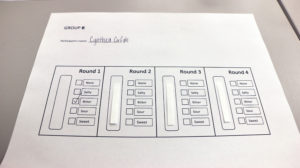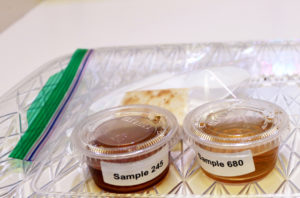
A look at LSU AgCenter Sensory Services Lab’s new taste program series
Editor’s note: This article has been updated to reflect that the series is in partnership with Geaux Rouge.
If you asked me whether I’d consider myself to be a “supertaster,” I’d probably say yes.
This is coming from the granddaughter of two Liberian grandparents who cook fish, greens and rice so spicy you’ll be begging for a glass of milk to relieve your tastebuds.
But, what exactly is a supertaster? I found the answer during a recent visit to LSU AgCenter’s Sensory Services Lab.
|
|
The Sensory Services Lab, which is at the LSU AgCenter, provides consultation, services and education to food and non-food industries across the country and the world. Its services range from consumer research to sensory evaluation.
During the first of the Lab’s new research and taste experiment program series in partnership with Geaux Rouge, I toured the facility and tested my taste buds.
 I joined a group of 20 participants, ranging from local media to restaurant owners to general foodies. We were given a sheet of paper with four flavored strips taped to it, each representing a different round of tasting.
I joined a group of 20 participants, ranging from local media to restaurant owners to general foodies. We were given a sheet of paper with four flavored strips taped to it, each representing a different round of tasting.
LSU professor Dr. Witoon Prinyawiwatkul instructed participants to remove one strip of paper at a time, taste it, mark what flavor we tasted first, sip water and repeat. After we licked each strip, we had the option to choose from the following flavor profiles: none, salty, bitter, sour and sweet.
I tasted each strip, let the taste sit for a few seconds, took a sip of water, then moved to the next one. My results were: bitter, sour, salty and bitter.
After we finished the supertaster test, we toured the Sensory Services lab, took a peek at the School of Nutrition and Food Services’ state-of-the-art demonstration kitchen and participated in another taste test.
 During the second taste test, we tried two small cups of syrup, one dark and one light. We were asked a series of questions about them including the sweetness and viscosity, both of which I thought were different. (Spoiler alert: I was wrong!)
During the second taste test, we tried two small cups of syrup, one dark and one light. We were asked a series of questions about them including the sweetness and viscosity, both of which I thought were different. (Spoiler alert: I was wrong!)
I wasn’t alone, though. The majority of the participants said that the darker syrup was sweeter. However, both syrups contained the same amount of sweetness but differed in thickness and color. The test showed how much our eyes can deceive us when it comes to our food preferences.
At the end of the night, my test results revealed that I was a standard supertaster, falling in the middle on a scale of normal taster to standard supertaster to true supertaster.
Prinyawiwatkul says supertasters are often sensitive to bitter tastes and sugar. They usually don’t like raw broccoli or the taste of fat. He also says 25 percent of females, African-Americans and Asians are considered supertasters.
Watch for updates about future events on the Geaux Rouge page. The Sensory Services Lab is always looking for other volunteers to join Tiger Tasters, an experimental group of tasters that helps companies conduct sensory evaluations by product testing. To sign up, fill out its survey, and you will be added to the database.
Learn more about the Sensory Services Lab and how to become a Tiger Taster here.
|
|
|

